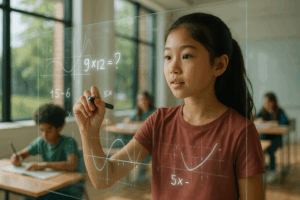Introduction
It’s 10:45 a.m. in Austin, and the classroom looks nothing like the one most parents remember. Students wearing headphones work independently through math and reading challenges at their own pace while a guide checks progress dashboards. By lunchtime, their academic day is done.
Could kids really master a full year of learning in just two hours a day?
Alpha School’s “two-hour school day” model says yes. Powered by AI tutors and mastery-based learning science, Alpha students complete a full grade level in about 20–30 hours of focused study—roughly ten times faster than traditional pacing. Third-party MAP Growth tests show they perform in the top 1–2 percent nationally, achieving about 2.3× annual growth compared with peers.
In This Guide
- What Makes a Two-Hour School Day Work
- Evaluation Criteria: Measuring Learning Efficiency
- Inside Alpha’s Two-Hour Model
- The Science Behind Faster Learning
- FAQs About the Two-Hour Day
- Conclusion & Next Steps
Evaluation Criteria: Measuring Learning Efficiency
Researchers and parents alike often equate learning time with outcomes. But decades of data suggest quality beats quantity. Alpha’s approach rests on five research-backed criteria:
Mastery Evidence – Benjamin Bloom’s 1984 2 Sigma Problem showed that one-on-one mastery tutoring could raise performance two standard deviations—turning an average student into a 98th-percentile learner. Alpha’s model applies this digitally: students advance only after achieving at least 90 percent mastery.
Feedback Loops – John Hattie’s meta-analysis (2023) places formative feedback among the strongest influences on achievement (effect size ≈ 0.7). Alpha’s platform builds this directly into every session.
Motivation / “Time Back” Effect – “Motivation is 90 percent of the solution,” says Joe Liemandt. Earning back time for projects becomes the ultimate motivator.
Personalization Depth – The AI engine tailors each lesson to a learner’s “knowledge grade,” pinpointing precisely what they know and don’t.
Guide Support & Human Connection – Guides act as mentors and motivators rather than lecturers. Staffing is typically around one guide per dozen students, according to Alpha’s internal plan.
What Makes a Two-Hour School Day Work
A two-hour model succeeds when every minute is spent on high-yield practice, feedback, and mastery rather than seat time. Traditional classrooms devote large portions of the day—often around half—to non-instructional activities such as transitions and review.
At Alpha, mornings start with a short goal-setting check-in, followed by personalized academic sessions until mastery targets are met.
“Our kids learn at a rate that’s never been possible before—about a grade level in twenty-two hours… roughly ten times faster than the current system.”
Students missing prior fundamentals can close gaps fast—about 40–60 hours of targeted study to rebuild an entire grade level. The mastery approach replaces “I’m just bad at math” with “I haven’t learned that yet.”
Inside Alpha’s Two-Hour Model
Alpha’s learning environment feels more like a startup workspace than a traditional school. Instead of teachers lecturing, students progress through individualized digital lessons on Alpha’s proprietary TimeBack platform.
- Personalized Pathways: Diagnostics identify mastery gaps, generating lessons at each child’s level.
- Mastery Tracking: Advancement requires 90 percent accuracy or higher before new material unlocks.
- Measured Outcomes: MAP Growth data show an average of 2.3× yearly progress compared with U.S. norms.
- Life-Skills Afternoons: Once academics are done, students spend the rest of the day on entrepreneurship, athletics, leadership, and public-speaking workshops.
Guides—often professionals from outside education—coach motivation and resilience. They report reduced after-school grading and planning because feedback is automated.
The Science Behind Faster Learning
- Cognitive Efficiency
Cognitive-load theory holds that working memory has limited capacity. When students lack automatic recall of basics like multiplication tables, they waste that capacity on low-level processing. Alpha rebuilds fluency first, freeing bandwidth for higher reasoning. - Motivation as a Multiplier
Self-Determination Theory (Deci & Ryan, 2000) shows autonomy and purpose drive motivation. The “two-hour day” embeds autonomy: once mastery goals are met, students reclaim their afternoon. Liemandt calls this “the psychological unlock every kid needs to re-engage.” - Continuous Feedback
Alpha’s AI tutors act as performance coaches, monitoring behavior rather than simply grading answers. The system flags when a student scrolls too quickly or skips material, prompting self-correction. - Staying in the Sweet Spot
Lessons are tuned so students answer correctly about 80–85 percent of the time—the ideal “zone of proximal development” where learning feels challenging but attainable.
FAQs About the Two-Hour Day
Q1. Does less time mean less rigor?
No. In mastery learning, rigor means achieving complete understanding, not logging hours. Bloom (1984) showed mastery tutoring can double performance even with reduced seat time.
Q2. What happens after academics?
Afternoons shift to hands-on, collaborative work—from operating food trucks to training for 5Ks and producing musicals.
Q3. How much screen time is involved?
Academic blocks use short, focused intervals; Liemandt emphasizes intensity over duration. The remainder of the day is offline and team-based.
Q4. Can this model work in public schools?
Yes. Liemandt’s goal is to scale the TimeBack platform globally via a sub-$1,000 tablet capable of offline AI tutoring.
Q5. How do parents verify results?
Alpha uses third-party MAP Growth tests. Results confirm roughly double the annual academic progress of same-age peers.
Conclusion & Next Steps
The two-hour school day redefines what counts as learning time. Research and real-world data show that focus, feedback, and motivation—not seat hours—determine mastery.
Liemandt argues that with individualized tutoring and mastery progression, nearly every child can reach top-decile performance by middle school. Artificial intelligence finally makes that scalable.
“It’s the best time in history to be a five-year-old,” Liemandt says.
By pairing AI precision with human mentorship, Alpha’s model reframes school as a launchpad for curiosity rather than confinement.
Parents can explore Alpha’s approach or schedule a visit at https://alpha.school/the-program/.



